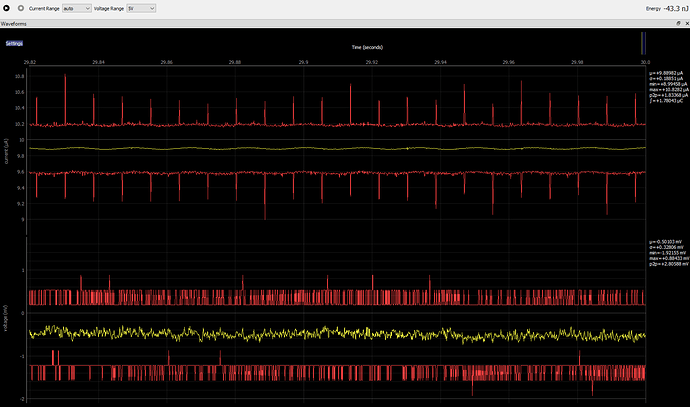I got my Joulescope set up today. I’m really happy about the painless install process. The first thing I tried was to test it on some current sources that I have (picoamp sources and electrometers configured as current source). I’ve found a potential issue (and a potentially useful note for the User’s Guide). I didn’t really dive deep into it but maybe you already know what’s going on.
The issue: when sourcing microamps into the Joulescope (so the Joulescope reads negative), I find that between -5µA and -42µA (inclusive) I get a very nasty autoranging that also seems to be 60Hz-triggered. At -43µA I get a very clean looking signal. From -44µA to -100µA I get a waveform with spikes every ~8ms. I haven’t taken a look with an oscilloscope to see if there’s something happening at an even higher frequency that isn’t being picked up in the Joulescope waveform mode, though I’m not sure why it would only happen in one polarity. See Figures 1 & 2 below. It’s obviously changing ranges, the problem disappears with range=180µA.
Figure 1: -10µA source, OUT- grounded, range = auto
Figure 2: -10µA source, OUT- grounded, range = 180µA
In Figure 3 you’ll notice that when I swap polarity, the autoranging stops and the measurement is spot on. I swapped polarity at the source, not by swapping the banana plugs (this is important because my source is chassis-referenced and the chassis is grounded).
Figure 3: +10µA sink, OUT- grounded, range = auto
Also, I think you may want to add a note in the User’s Guide about the imbalance between the positive and negative terminals and the effect that can have on ground-related interference. By swapping around the banana plugs, tying the positive side to chassis / ground, I see a dramatic difference in behavior. I will note that the autoranging behavior is the same when I swap the banana plug polarity (ie, when I source -10µA, I get weird autoranging, when I source +10µA I do not see the autoranging), which means it is not related to a difference of the + and - operation of the picoamp source.
Figure 4: +10µA sink, OUT+ grounded, range = auto
My test setup is not ideal but this was a quick test. I’m using a Keithley 261 picoamp source (I’ve also tried a Keithley 610C electrometer as the 10µA current source, it exhibits the same behavior). I have the IN+/IN- terminals shorted together. I tried plugging the IN into a power supply at various voltages from 0-5V but saw no change in behavior. I have the picoamp source plugged into the Joulescope’s OUT port through a some coax to a BNC-to-dual-banana adapter. Obviously my setup adds to the imbalance issue, but if the Joulescope were itself balanced then it shouldn’t matter, you’d have the same chassis/shield-coupled interference whether you plugged the shield into the negative or positive terminal.
Any thoughts about what’s going on with the -µA measurements?
Thanks,
Nick




 . In the Figure 4 case, IN+ is left floating and only connected through the Joulescope shunt resistor (1111 Ω in 18 µA range) and whatever circuitry is in your sink. You will pick up additional noise in this case.
. In the Figure 4 case, IN+ is left floating and only connected through the Joulescope shunt resistor (1111 Ω in 18 µA range) and whatever circuitry is in your sink. You will pick up additional noise in this case. 
